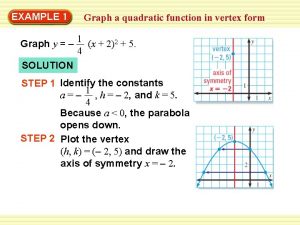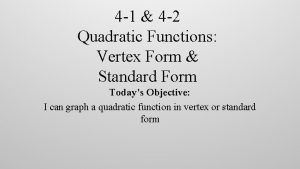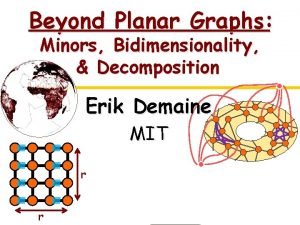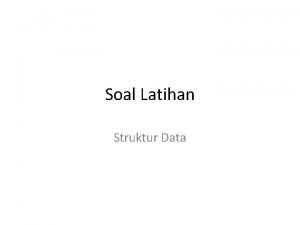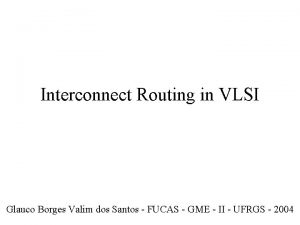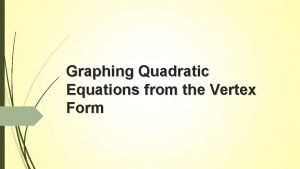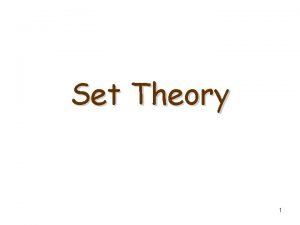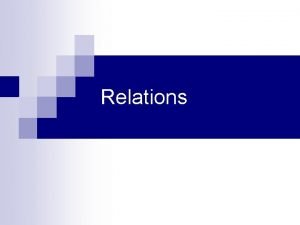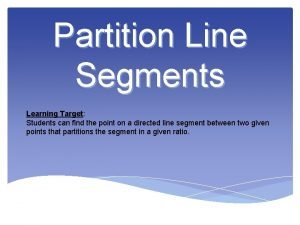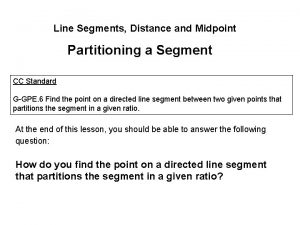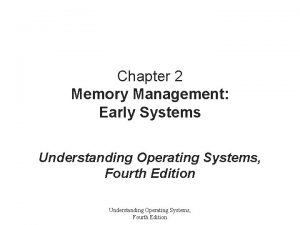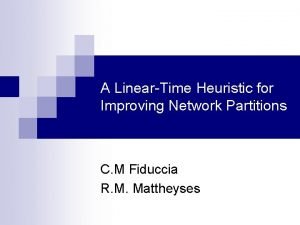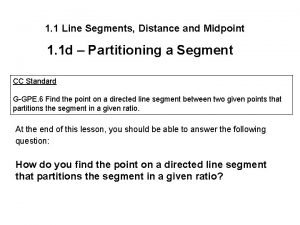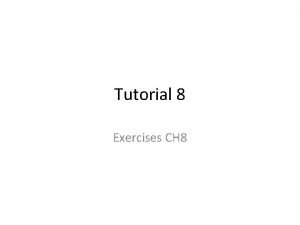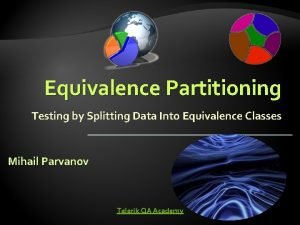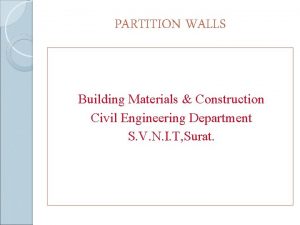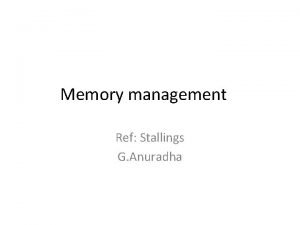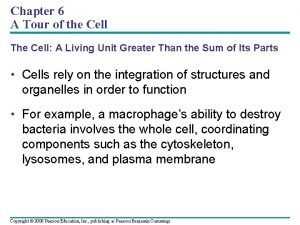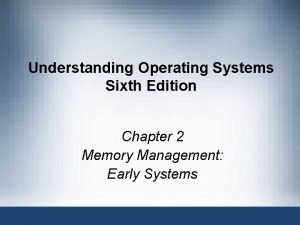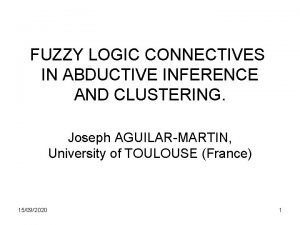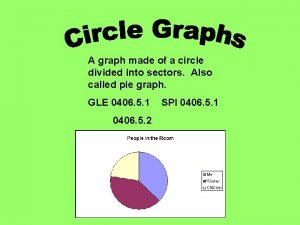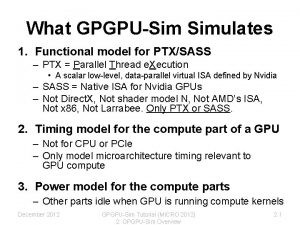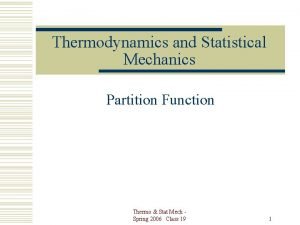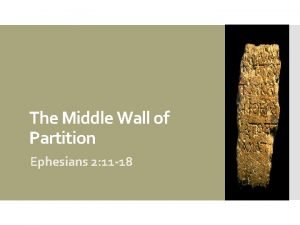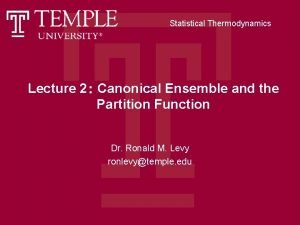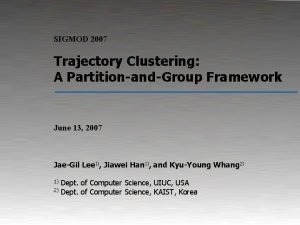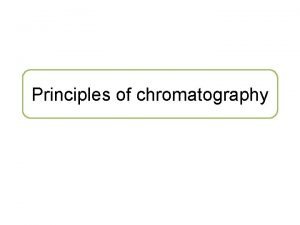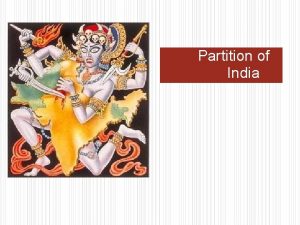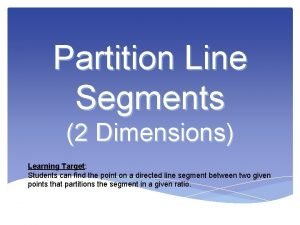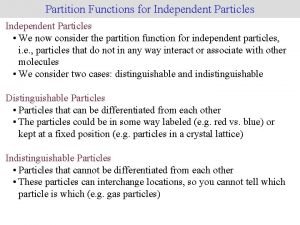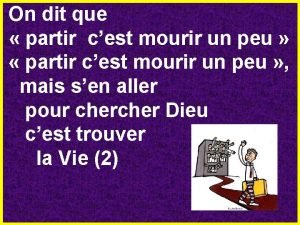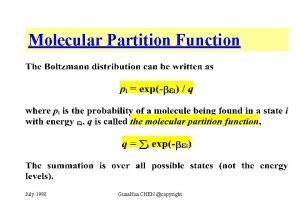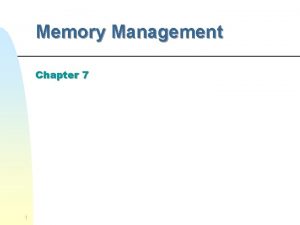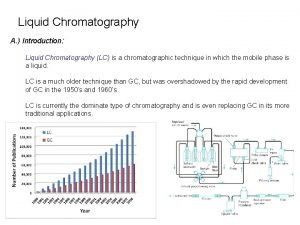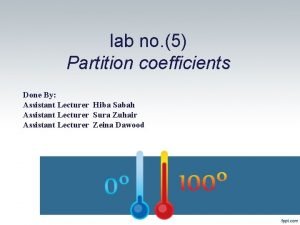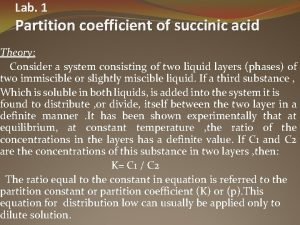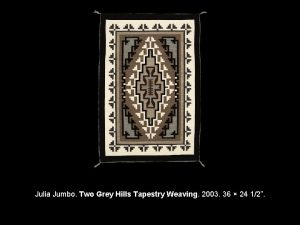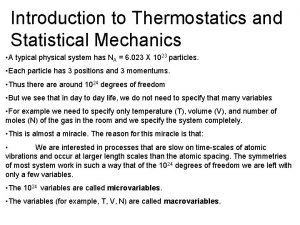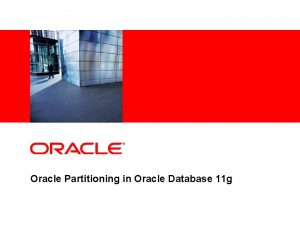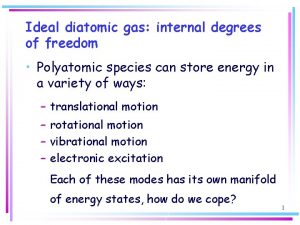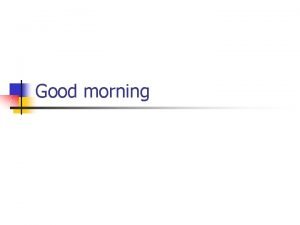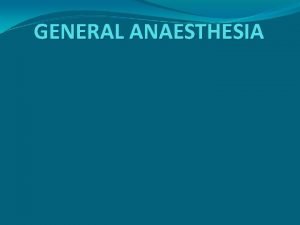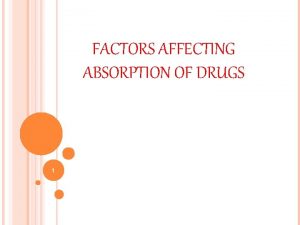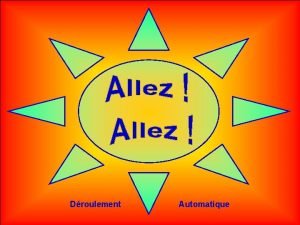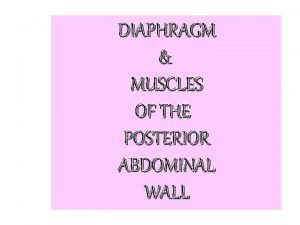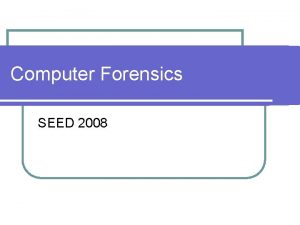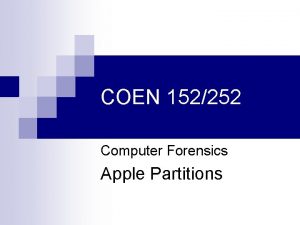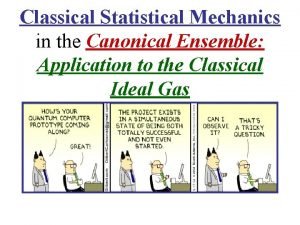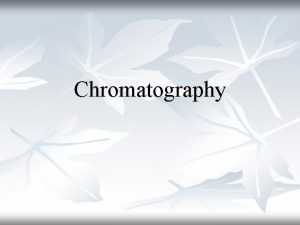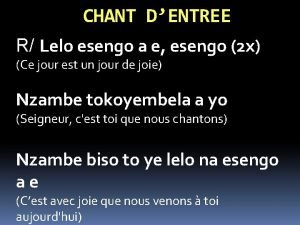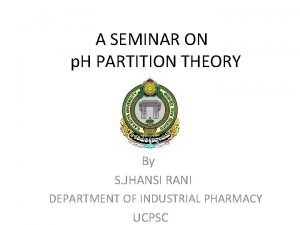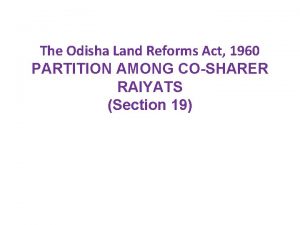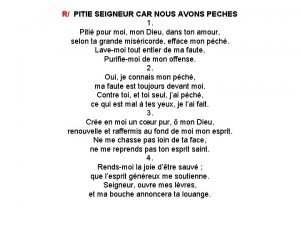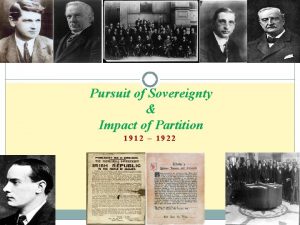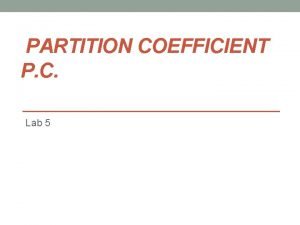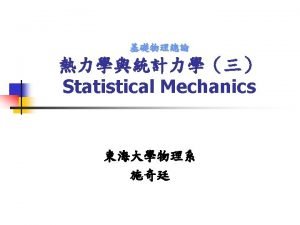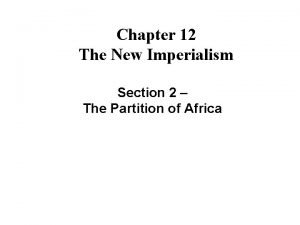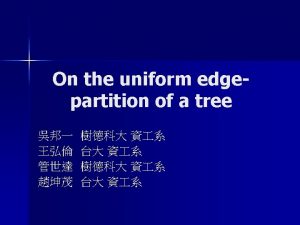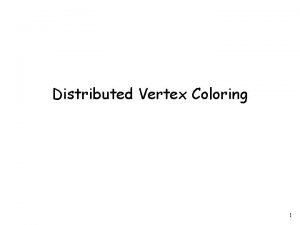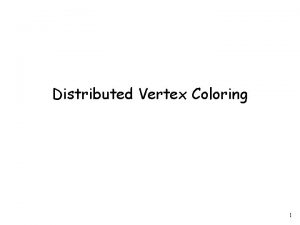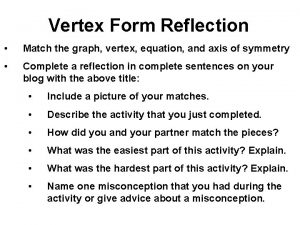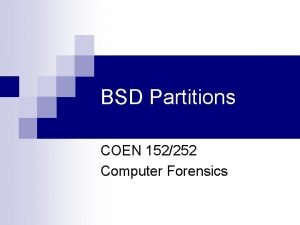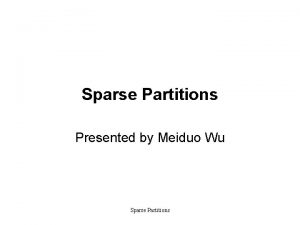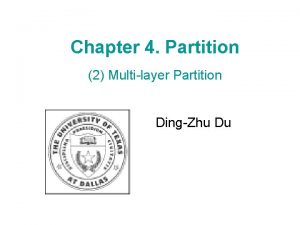Graph Partitions Vertex partitions Partition VG into k
























![Deciding if G is split Algorithm succeeds No forbidden subgraphs A splitting exists [H-Klein-Nogueira-Protti] Deciding if G is split Algorithm succeeds No forbidden subgraphs A splitting exists [H-Klein-Nogueira-Protti]](https://slidetodoc.com/presentation_image/41b2c4424a6d9bc3a4c7d03c6bf7012d/image-25.jpg)






















![Classified PART(M) • M has no 1’s (or no 0’s) [H-Nesetril, Feder-H-Huang] Classified PART(M) • M has no 1’s (or no 0’s) [H-Nesetril, Feder-H-Huang]](https://slidetodoc.com/presentation_image/41b2c4424a6d9bc3a4c7d03c6bf7012d/image-48.jpg)
![Classified PART(M) • M has no 1’s (or no 0’s) [H-Nesetril, Feder-H-Huang] PART(M) is Classified PART(M) • M has no 1’s (or no 0’s) [H-Nesetril, Feder-H-Huang] PART(M) is](https://slidetodoc.com/presentation_image/41b2c4424a6d9bc3a4c7d03c6bf7012d/image-49.jpg)

![Classified PART(M) • M has no 1’s (or no 0’s) [H-Nesetril, Feder-H-Huang] • M Classified PART(M) • M has no 1’s (or no 0’s) [H-Nesetril, Feder-H-Huang] • M](https://slidetodoc.com/presentation_image/41b2c4424a6d9bc3a4c7d03c6bf7012d/image-51.jpg)
![Classified PART(M) • M has no 1’s (or no 0’s) [H-Nesetril, Feder-H-Huang] • M Classified PART(M) • M has no 1’s (or no 0’s) [H-Nesetril, Feder-H-Huang] • M](https://slidetodoc.com/presentation_image/41b2c4424a6d9bc3a4c7d03c6bf7012d/image-52.jpg)






![Infinitely many forbidden induced subgraphs occur • whenever M contains • or [Feder-H-Xie] Infinitely many forbidden induced subgraphs occur • whenever M contains • or [Feder-H-Xie]](https://slidetodoc.com/presentation_image/41b2c4424a6d9bc3a4c7d03c6bf7012d/image-59.jpg)








![BUT… …there are problems PART(M), restricted to chordal graphs G, which are NP-complete [Feder-H-Klein-Nogueira-Protti] BUT… …there are problems PART(M), restricted to chordal graphs G, which are NP-complete [Feder-H-Klein-Nogueira-Protti]](https://slidetodoc.com/presentation_image/41b2c4424a6d9bc3a4c7d03c6bf7012d/image-68.jpg)















- Slides: 83

Graph Partitions

Vertex partitions Partition V(G) into k sets (k=3)

This kind of circle depicts an arbitrary set This kind of line means there may be edges between the two sets

Special properties of partitions • Sets may be required to be independent

This kind of circle depicts an independent set

This is just a k-colouring (k=3)

Deciding if a k-colouring exists is in P for k =1, 2 NP-complete for all other k (k=2)

Deciding if a 2 -colouring exists 1 Obvious algorithm: 2 2 1 1 2 1 (k=2)

Deciding if a 2 -colouring exists Algorithm succeeds No odd cycles 2 -colouring exists

Deciding if a 2 -colouring exists Algorithm succeeds No odd cycles 2 -colouring exists

Deciding if a 2 -colouring exists Algorithm succeeds No odd cycles 2 -colouring exists

G has a 2 -colouring (is bipartite) if and only if it contains no induced 3 5 7 . . .

Special properties of partitions Sets may be required to have no edges joining them

This kind of dotted line means there are no edges joining the two sets

This is (corresponds to) a homomorphism. Here a homomorphism to C 5 - also known as a C 5 -colouring.

A homomorphism of G to H (or an H-colouring of G) is a mapping f : V(G) V(H) such that uv E(G) implies f(u)f(v) E(H). A homomorphism f of G to C 5 corresponds to a partition of V(G) into five independent sets with the right connections.

f -1(1) f -1(2) f -1(5) f -1(3) f -1(4) 1 2 5 3 4 C 5

1 2 5 3 4

Special properties of partitions • Sets may be required to be cliques

This kind of circle depicts a clique

This is just a colouring of the complement of G

G is a split graph if it is partitionable as

Deciding if G is a split graph is in P

G is split graph if and only if it contains no induced 4 5
![Deciding if G is split Algorithm succeeds No forbidden subgraphs A splitting exists HKleinNogueiraProtti Deciding if G is split Algorithm succeeds No forbidden subgraphs A splitting exists [H-Klein-Nogueira-Protti]](https://slidetodoc.com/presentation_image/41b2c4424a6d9bc3a4c7d03c6bf7012d/image-25.jpg)
Deciding if G is split Algorithm succeeds No forbidden subgraphs A splitting exists [H-Klein-Nogueira-Protti]

This is a clique cutset (assuming all parts are nonempty)

Deciding if G has a clique cutset • is in P • has applications in solving optimization problems on chordal graphs [Tarjan, Whitesides, …]

G is a chordal graph if it contains no induced 4 5 6 . . .

G is a chordal graph if it contains no induced 4 5 6 . . . if and only if every induced subgraph is either a clique or has a clique cutset [Dirac]

G is a cograph if it contains no induced

G is a cograph if it contains no induced if and only if every induced subgraph is partitionable as or [Seinsche]

This kind of line means all possible edges are present

A homogeneous set (module) Another well-known kind of partition

A homogeneous set (module) • finding one is in P • has applications in decomposition and recognition of comparability graphs (and in solving optimization problems on comparability graphs) [Gallai…]

G is a perfect graph = holds for G and all its induced subgraphs.

G is a perfect graph = holds for G and all its induced subgraphs. G is perfect if and only if G and its complement contain no induced 3 5 7 . . . [Chudnovsky, Robertson, Seymour, Thomas]

Perfect graphs • contain bipartite graphs, line graphs of bipartite graphs, split graphs, chordal graphs, comparability graphs • and their complements, and • model many max-min relations. [Berge]

Perfect graphs • contain bipartite graphs, line graphs of bipartite graphs, split graphs, chordal graphs, comparability graphs • and their complements, and • model many max-min relations. Basic graphs

G is perfect if and only if it is basic or it admits a partition … all others [Chudnovsky, Robertson, Seymour, Thomas]

Special properties of partitions Sets may be required to be • Independent sets • cliques • or unrestricted Between the sets we may require no edges all edges or no restriction

The matrix M of a partition M(i, i) = 0 if Vi is independent 1 if Vi is a clique * if Vi is unrestricted M(i, j) = 0 if Vi and Vj are not joined 1 if Vi and Vj are fully joined * if Vi to Vj is unrestricted

The problem PART(M) • Instance: A graph G • Question: Does G admit a partition according to the matrix M ?

The problem SPART(M) • Instance: A graph G • Question: Does G admit a surjective partition according to M ? (the parts are non-empty)

The problem LPART(M) • Instance: A graph G, with lists • Question: Does G admit a list partition according to M ? (each vertex is placed to a set on its list)

For PART(M) we assume NO DIAGONAL ASTERISKS * M has a diagonal of k zeros and l ones (k+l=n)

Small matrices M • When |M| ≤ 4: PART(M) classified as being in P or NP-complete [Feder-H-Klein-Motwani] • When |M| ≤ 4: SPART(M) classified as being in P or NP-complete [de. Figueiredo-Klein-Gravier-Dantas] except for one matrix M

Small matrices M with lists • When |M| ≤ 4: LPART(M) classified as being in P or NP-complete, except for one matrix [Feder-H-Klein-Motwani] [de Figueiredo-Klein-Kohayakawa-Reed] [Cameron-Eschen-Hoang-Sritharan] • When |M| ≤ 3: digraph partition problems classified as being in P or NP-complete [Feder-H-Nally]
![Classified PARTM M has no 1s or no 0s HNesetril FederHHuang Classified PART(M) • M has no 1’s (or no 0’s) [H-Nesetril, Feder-H-Huang]](https://slidetodoc.com/presentation_image/41b2c4424a6d9bc3a4c7d03c6bf7012d/image-48.jpg)
Classified PART(M) • M has no 1’s (or no 0’s) [H-Nesetril, Feder-H-Huang]
![Classified PARTM M has no 1s or no 0s HNesetril FederHHuang PARTM is Classified PART(M) • M has no 1’s (or no 0’s) [H-Nesetril, Feder-H-Huang] PART(M) is](https://slidetodoc.com/presentation_image/41b2c4424a6d9bc3a4c7d03c6bf7012d/image-49.jpg)
Classified PART(M) • M has no 1’s (or no 0’s) [H-Nesetril, Feder-H-Huang] PART(M) is in P if M corresponds to a graph which has a loop or is bipartite, and it is NP-complete otherwise LPART(M) is in P if M corresponds to a bi-arc graph, and it is NP-complete otherwise

Bi-Arc Graphs Defined as (complements of) certain intersection graphs… A common generalization of interval graphs (with loops) and (complements of) circular arc graphs of clique covering number two (no loops).
![Classified PARTM M has no 1s or no 0s HNesetril FederHHuang M Classified PART(M) • M has no 1’s (or no 0’s) [H-Nesetril, Feder-H-Huang] • M](https://slidetodoc.com/presentation_image/41b2c4424a6d9bc3a4c7d03c6bf7012d/image-51.jpg)
Classified PART(M) • M has no 1’s (or no 0’s) [H-Nesetril, Feder-H-Huang] • M has no *’s
![Classified PARTM M has no 1s or no 0s HNesetril FederHHuang M Classified PART(M) • M has no 1’s (or no 0’s) [H-Nesetril, Feder-H-Huang] • M](https://slidetodoc.com/presentation_image/41b2c4424a6d9bc3a4c7d03c6bf7012d/image-52.jpg)
Classified PART(M) • M has no 1’s (or no 0’s) [H-Nesetril, Feder-H-Huang] • M has no *’s All PART(M) and LPART(M) in P [Feder-H]

CSP(H) Given a structure T with vertices V(H) and relations R 1(H), … Rk(H) of arities r 1, …, rk Decide whether or not an input structure G with vertices V(G) and relations R 1(G), … Rk(G), of the same arities r 1, …, rk admits a homomorphism f of G to H. DICHOTOMY CONJECTURE [Feder-Vardi] Each CSP(H) is in P or is NP-complete

Can all PART(M) be classified? If for every matrix M the problem PART(M) is in P or is NP-complete, then the Dichotomy Conjecture is true. [Feder-H] Thus hoping to classify all problems PART(M) appears to be overly ambitious…

G is complete bipartite if and only if it contains no induced

G is a split graph if and only if it contains no induced 4 5

G is a bipartite graph if and only if It contains no induced 3 5 7 . . .

Another classification of PART(M)? For which matrices M can the problem PART(M) be described by finitely many forbidden induced subgraphs?
![Infinitely many forbidden induced subgraphs occur whenever M contains or FederHXie Infinitely many forbidden induced subgraphs occur • whenever M contains • or [Feder-H-Xie]](https://slidetodoc.com/presentation_image/41b2c4424a6d9bc3a4c7d03c6bf7012d/image-59.jpg)
Infinitely many forbidden induced subgraphs occur • whenever M contains • or [Feder-H-Xie]

Do all others have finite sets of forbidden induced subgraphs? k l

Do all others have finite sets of forbidden induced subgraphs? NO…

For small matrices M • If |M| ≤ 5, all other partition problems have only finitely many forbidden induced subgraphs • If |M| = 6, there are other partition problems that have infinitely many forbidden induced subgraphs [Feder-H-Xie]

means without • If |M| ≤ 5, all other partition problems have only finitely many forbidden induced subgraphs • If |M| = 6, there are other partition problems that have infinitely many forbidden induced subgraphs [Feder-H-Xie]

Restrictions to inputs G Since these partitions relate closely to perfect graphs, we may want to restrict attention to (classes of) perfect graphs G

If M is normal The problem PART(M) restricted to perfect graphs G is in P [Feder-H] (fmfs)

BUT… …classifying PART(M), for perfect G, as being in P or being NP-complete, would still solve the dichotomy conjecture

If M is crossed The problem PART(M) restricted to chordal graphs G is in P [Feder-H-Klein-Nogueira-Protti]
![BUT there are problems PARTM restricted to chordal graphs G which are NPcomplete FederHKleinNogueiraProtti BUT… …there are problems PART(M), restricted to chordal graphs G, which are NP-complete [Feder-H-Klein-Nogueira-Protti]](https://slidetodoc.com/presentation_image/41b2c4424a6d9bc3a4c7d03c6bf7012d/image-68.jpg)
BUT… …there are problems PART(M), restricted to chordal graphs G, which are NP-complete [Feder-H-Klein-Nogueira-Protti]

For all M A cograph G has a partition if and only if G does not contain one of a finite set of forbidden induced subgraphs [Feder-H-Hochstadter]

Are these problems CSP’s? • Yes - two adjacent vertices of G have certain allowed images in H and two nonadjacent vertices of G have certain allowed images in H. (Two binary relations)

Are these problems CSP’s? • Yes - two adjacent vertices of G have certain allowed images in H and two nonadjacent vertices of G have certain allowed images in H. (Two binary relations) • No - this is not a CSP(T), as inputs are restricted to have each pair of distinct variables in a unique binary relation.

Full CSP’s • Given a set L of positive integers, an L-full structure G has each k L elements in a unique k-ary relation • CSPL(H) is CSP(H) restricted to L-full structures G

Example with m binary relations Given a complete graph with edges coloured by 1, 2, … , m. Given such a G, colour the vertices 1, 2, …, m, without a monochromatic edge i i i

When m = 2, the problem is in P

When m = 2, the problem is in P When m 4, it is NP-complete

When m = 2, the problem is in P When m 4, it is NP-complete When m = 3, we only have algorithms of complexity [FHKS] n O ( log n / log n )

An algorithm of complexity n. O(log n) solving the (more general) problem with lists Given a complete graph G with edges coloured by 1, 2, 3, and vertices equipped with lists {1, 2, 3}

If all lists have size 2 Introduce a boolean variable for each vertex (use the first/second member of its list) Express each edge-constraint as a clause of two variables Solve by 2 -SAT

In general Let X be the set of vertices with lists {1, 2, 3} Recursively reduce |X| as follows: Try to colour G without giving any vertex its majority colour Give each vertex in turn its majority colour X X (|X|-1) / 3 X

Analysis of Recursive Algorithm Time to solve problem with |X|= x T(x) = (1 + x T(2 x/3)). T(2 -SAT)

Analysis of Recursive Algorithm Time to solve problem with |X|= x T(x) = (1 + x T(2 x/3)). T(2 -SAT) T(x) = x O(log x)

Analysis of Recursive Algorithm Time to solve problem with |X|= x T(x) = (1 + x T(2 x/3)). T(2 -SAT) T(x) = x O(log x) T(n) = n O(log n)

Can we say anything ? A kind of (quasi) dichotomy If 1 L then every CSPL(H) is quasi-polynomial or NP-complete [Feder-H]
 Vertex on graph
Vertex on graph Standard form graphing
Standard form graphing Apex vertex in graph theory
Apex vertex in graph theory Suatu simpul terpencil memiliki derajat simpul sebanyak
Suatu simpul terpencil memiliki derajat simpul sebanyak Latihan struktur
Latihan struktur Nanda valim
Nanda valim Simplified form of quadratic equation
Simplified form of quadratic equation Vertex form equation
Vertex form equation Whats vertex form
Whats vertex form Bc scientific notation
Bc scientific notation Hasse diagram for positive divisors of 36
Hasse diagram for positive divisors of 36 Partition a line segment
Partition a line segment Partitioning a segment
Partitioning a segment Relocatable dynamic partitions in os
Relocatable dynamic partitions in os A linear-time heuristic for improving network partitions
A linear-time heuristic for improving network partitions Quiz 1-2 distance and midpoint partitioning a segment
Quiz 1-2 distance and midpoint partitioning a segment Given six memory partitions of 300kb 600kb
Given six memory partitions of 300kb 600kb Equivalence partitions
Equivalence partitions Sys.indexes
Sys.indexes Structures of composite cell
Structures of composite cell Lab 5-2: create partitions and filesystems
Lab 5-2: create partitions and filesystems Brick nogging partition
Brick nogging partition Fixed partitions
Fixed partitions Membranous sacs with interior partitions
Membranous sacs with interior partitions Relocatable dynamic partitions
Relocatable dynamic partitions Lab 5-2: create partitions and filesystems
Lab 5-2: create partitions and filesystems Logika partitions
Logika partitions Line graph graph theory
Line graph graph theory Resource allocation graph and wait for graph
Resource allocation graph and wait for graph Circular graph divided into sectors
Circular graph divided into sectors Gpgpu sim tutorial
Gpgpu sim tutorial Stat
Stat Breaking down the middle wall of partition
Breaking down the middle wall of partition Input space partition testing
Input space partition testing Partition function in statistical mechanics
Partition function in statistical mechanics The trajectory
The trajectory Principle of chromatography
Principle of chromatography Radcliffe line
Radcliffe line Partition point formula
Partition point formula Translational energy
Translational energy What is partition coefficient
What is partition coefficient Ouvre mes yeux seigneur partition pdf
Ouvre mes yeux seigneur partition pdf Virtual memory os
Virtual memory os Choisir c'est mourir un peu
Choisir c'est mourir un peu Nombreux comme le sable des plages paroles
Nombreux comme le sable des plages paroles Nous sommes le peuple de la longue marche
Nous sommes le peuple de la longue marche Vibrational partition function
Vibrational partition function Buddy system in os
Buddy system in os Memory partition
Memory partition Partition chromatography
Partition chromatography Partition coefficient
Partition coefficient Distribution coefficient of succinic acid
Distribution coefficient of succinic acid Grizzly bear house partition screen
Grizzly bear house partition screen Relation between partition function and internal energy
Relation between partition function and internal energy Oracle interval partitioning by month example
Oracle interval partitioning by month example Il faut chanter pour toutes les mamans du monde
Il faut chanter pour toutes les mamans du monde Vibrational partition function
Vibrational partition function Internal thoracic artery
Internal thoracic artery What is second gas effect
What is second gas effect Factors influencing drug absorption
Factors influencing drug absorption En todo amar y servir letra
En todo amar y servir letra Allez allez proclamer
Allez allez proclamer Diaphragm openings
Diaphragm openings Partition type
Partition type Partition type
Partition type Apple partition map
Apple partition map Partition function in statistical mechanics
Partition function in statistical mechanics Tswett
Tswett Nkembo na tata alleluia paroles
Nkembo na tata alleluia paroles Memory partition
Memory partition Bienvenue
Bienvenue Le grain qui meurt a porté fruit partition
Le grain qui meurt a porté fruit partition Partion manager
Partion manager Ph partition hypothesis
Ph partition hypothesis Je me tiens à la porte et je frappe partition
Je me tiens à la porte et je frappe partition Olr act 1960
Olr act 1960 Postgresql range partition
Postgresql range partition Pitie seigneur car nous avons peche paroles
Pitie seigneur car nous avons peche paroles Pursuit of sovereignty and impact of partition essays
Pursuit of sovereignty and impact of partition essays Non non non ne failliront jamais lyrics
Non non non ne failliront jamais lyrics Iodine partition coefficient
Iodine partition coefficient Avance en eau profonde paroles
Avance en eau profonde paroles Difference between canonical and grand canonical ensemble
Difference between canonical and grand canonical ensemble Chapter 12 section 2 the partition of africa
Chapter 12 section 2 the partition of africa
